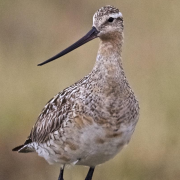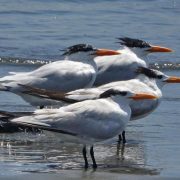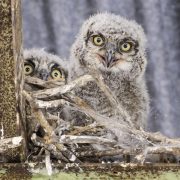Earth to Birds: Take the Next Left
Scientists have long thought that avian migration is guided by the magnetic field, but how, exactly? The search has led to three very different hypotheses.
By Sophie Fessl, Knowable Magazine
Every fall, the bar-tailed godwit takes to wing and flies nonstop from Alaska to New Zealand — a journey of 7,000-plus miles. Countless other birds head off too, bound for warmer spots before returning in the spring. How they do it without getting lost remains mysterious to this day.
Scientists are convinced birds must be using some type of biologically based magnetic compass, but they have yet to figure out how such a system would work. Now the field is heating up, and the latest research is pointing away from one long-standing theory and bolstering some intriguing alternatives.
Clues have been piling up for decades. Back in the 1960s, researchers discovered that European robins can somehow sense Earth’s magnetic field. In the decades since, scientists learned that robins and a variety of other bird species use the field, which is created by movement of iron in Earth’s core, as a navigational aid. The birds combine this guide with information deduced from the sun, the stars and geographical landmarks to complete their voyages.
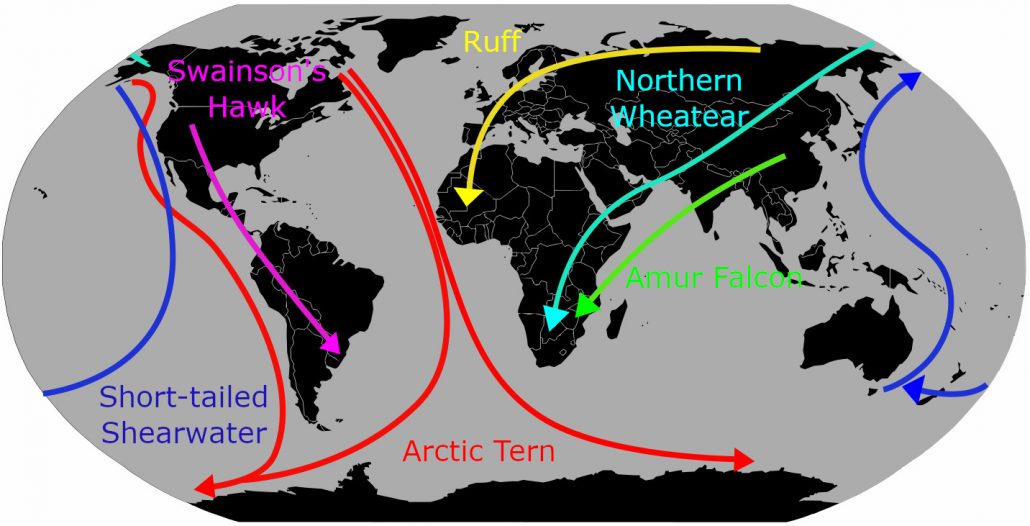
But a vexing question that remains is what sort of biological receptor birds use to detect the magnetic field.
“Key experiments by a group in Germany definitively showed that a magnetic sense exists. Now, more than 50 years later, we still don’t really understand how it works,” says neuroscientist David Keays of the Research Institute of Molecular Pathology in Vienna.
Today, researchers are focusing on three possible ways that a magnetic sense could work. One idea involves a form of iron with magnetic properties, called magnetite, acting as a sort of compass within cells that rotates to align with the magnetic field. Another contender, known as the radical-pair mechanism, hinges on a chemical reaction in a bird’s eye that is influenced by Earth’s magnetic field. A third hypothesis suggests that as a bird moves through Earth’s magnetic field, small currents are generated in the creature’s inner ear.
In all three of these scenarios, signals are produced and passed on to the bird’s brain to be processed and translated into directions. Here’s a look at each of them.
Testing their metal
The magnetite idea has been studied the longest. Though it is biologically possible — certain kinds of swimming bacteria use the iron mineral to orient themselves — evidence in higher animals remains elusive, with scattered reports that are not always reproducible.
“The history of the magnetite literature in vertebrates is basically, ‘I find magnetite here,’ ‘I find magnetite here,’ ‘I find magnetite here,’ but it’s not getting much further than that yet,” says biologist Henrik Mouritsen, who investigates magnetoreception in European robins and blackcaps and coauthored a 2016 overview of the topic in the Annual Review of Biophysics.
Mouritsen, of the University of Oldenburg in Germany, would like to test the magnetite hypothesis using a classic tool of biologists: Remove something from the animal and see what happens to its behavior. If magnetite is critical for navigation, destroying the magnetite-containing cells would affect the birds’ ability to find their way. But for this research strategy to work, scientists need to know just where to find magnetite in the robins. And even if they find it, “it’s a long way from showing a cell contains iron to showing it’s magnetite connected to nerve tissue that has any biological relevance,” Mouritsen says.
One major knock against the magnetite theory is that a bird’s compass senses only the axis of the magnetic field and not its polarity, says chemist Peter Hore of the University of Oxford, a coauthor on the Annual Reviews paper. Unlike the compass needles used by people, which rely on the magnetic field’s polarity to point toward the magnetic North Pole, birds know which direction the nearest pole is but can’t distinguish between north and south. So when scientists invert the magnetic field in the lab, birds don’t sense a change and continue to head in the same direction.
But magnetite particles would respond to a flipped field by pointing in the opposite direction, just like a compass needle would. If birds were depending on magnetite, they would sense the change and turn around to head in the opposite direction.
The eyes have it?
The weight of evidence gathered by scientists tilts toward another idea known as the radical-pair hypothesis, Hore says. Mouritsen also favors this idea, which is based on a protein in birds’ eyes called cryptochrome. When light hits cryptochrome, reactions within the protein generate a pair of molecules, called a radical pair. The two molecules in the pair each have an odd number of electrons, leaving each with a single, unpaired electron. These two extra electrons can have spins that are in the same (or parallel) direction, or in the opposite (antiparallel) direction, and they can also flip between these two states.
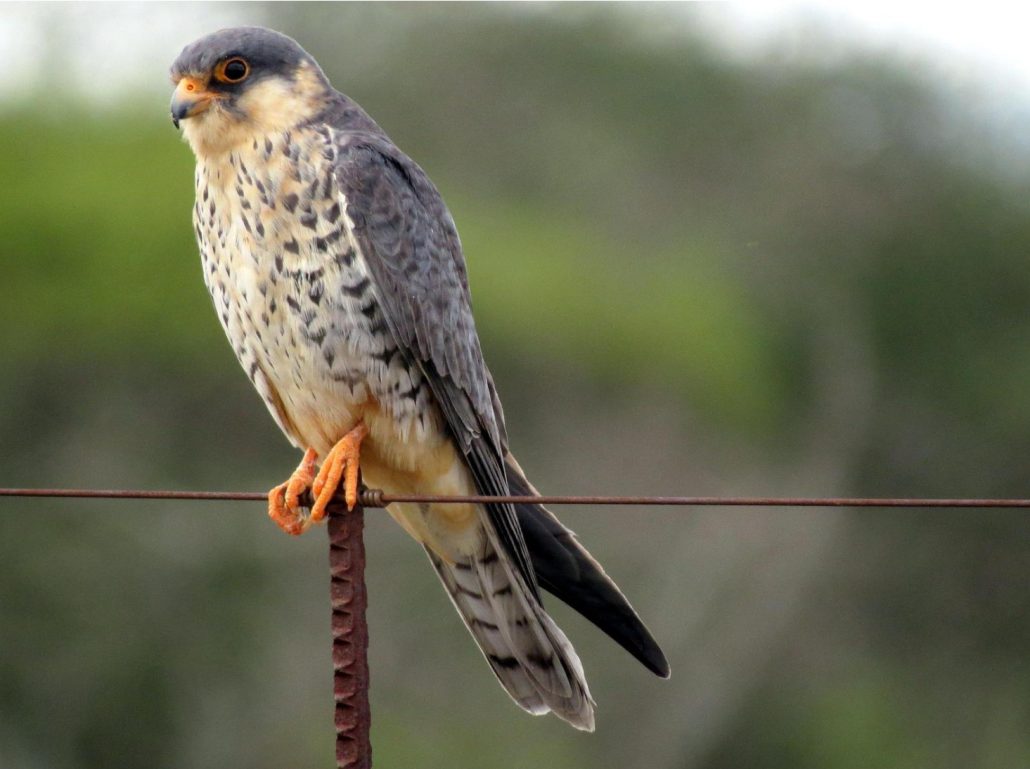
According to the radical-pair hypothesis, Earth’s magnetic field influences how likely the spins are to be parallel or antiparallel. How those spins are then translated into a compass isn’t certain, but scientists suspect that in a biochemical reaction in the bird’s eye, the two spin states could lead to different amounts of chemical products being made. The products could then influence signals sent from the bird’s retina to its brain, making it aware of the magnetic field.
A mechanism based on radical pairs instead of magnetite could potentially allow birds to detect magnetic fields, Keays agrees. But because the radical-pair system depends on light hitting birds’ eyes, he thinks there is probably more than one mechanism at work. “It seems counterintuitive to have a light-dependent magnetic sensor when you are flying at night,” he says.
Or maybe the ears do
Keays is testing a long-forgotten hypothesis, first proposed in 1882, that as a bird flies through Earth’s magnetic field, tiny electric currents are generated in its ear. This would happen through electromagnetic induction, akin to how a magnet that moves through a coiled wire creates an electric current in the wire. Extremely sensitive receptors would pick up the small voltages induced in the bird’s inner ear and send signals to the brain.
Electromagnetic induction is thought to be plausible in sharks and skates, which can sense electric currents in seawater. That same electrosensory system could potentially function as a sort of biological wire in which currents could be induced, allowing the animals to sense Earth’s magnetic field.
To test whether induction could work in a land animal like birds, Keays built a simple, scaled model of a pigeon’s inner ear: a plastic tube filled with conductive fluid. When he put the model in a rotating magnetic field, sure enough, a small current was induced. Keays suspects the pigeon behavior of rapid head-turning to scan the environment during flight may also serve to boost the voltage in the birds’ ears. He has also discovered a very sensitive electroreceptor in the pigeon’s inner ear, which is exactly where it would be needed for induction to work.
Though scientists in the field are finding many new and intriguing pieces of evidence, the definitive test that will finally reveal how birds “feel” the magnetic field has yet to be devised, Hore says. “What we need is a killer experiment that would have the power to show, once and for all, whether it really is radical pairs and whether it really is cryptochrome. But it’s actually very hard to come up with something.”
Sophie Fessl swapped the fruit fly, her favorite neuroscience model, for pen and paper and is now a freelance science writer based in Vienna. Follow her on Twitter: @brainosoph
This article originally appeared in Knowable Magazine on July 16, 2020. Knowable Magazine is an independent journalistic endeavor from Annual Reviews, a nonprofit publisher dedicated to synthesizing and integrating knowledge for the progress of science and the benefit of society. Sign up for the newsletter.

